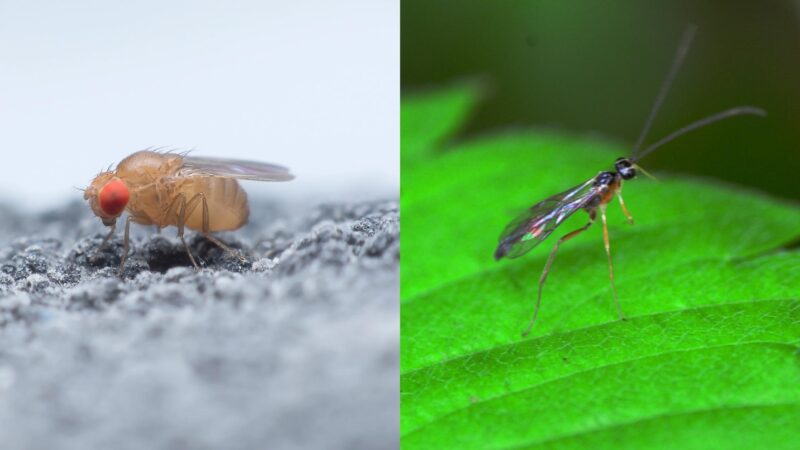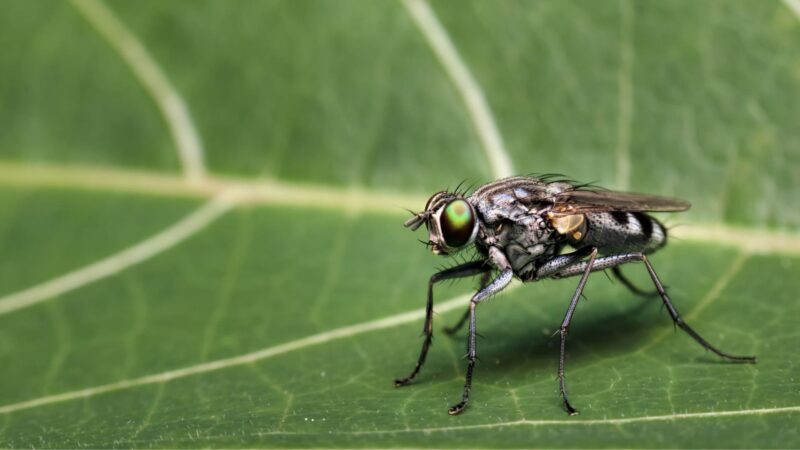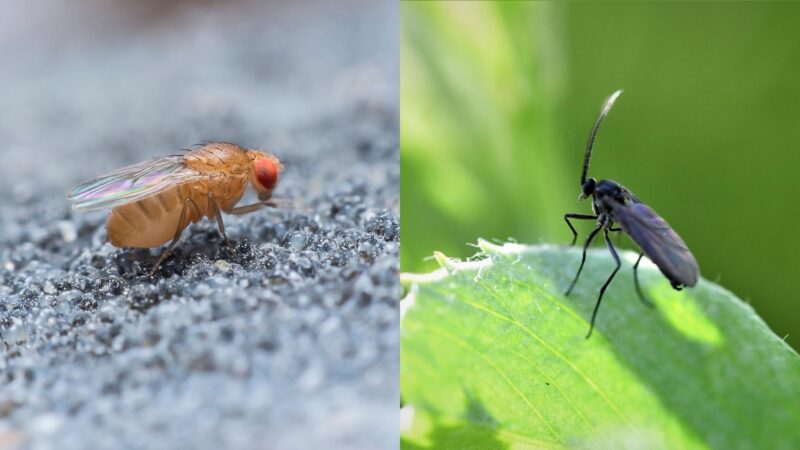Many people are confused between gnats and fruit flies, and sometimes, they mistake one for the other. This is because these two tiny insects are almost look-alikes.
With the naked eyes, spotting the difference can be very challenging. Sad to say, both of them can lead to an infestation in your home at the same time.
What’s the main difference between fruit flies and gnats? The main difference between fruit flies and gnats is their eating habits. They also have different impacts on humans. Adult fruit flies feed on fruits and can contaminate food. On the other hand, adult fungus gnats don’t eat, but their larvae damage plants.
In biological classification, fruit flies belong to the Drosophilidae family, while gnats are in the families Anisopodidae, Mycetophilidae, and Sciaridae.
Aside from that, these two destructive pests have a lot of interesting differences. This comprehensive guide will teach you everything about fruit flies and fungus gnats.
Table of Contents
Are Gnats and Fruit Flies the Same?
Gnats and fruit flies are not the same but are similar. In general, gnats are species of biting and non-biting small flying insects. Fruit flies and fungus gnats are often referred to as “gnats.”
Therefore, fruit flies are gnats, but not all gnats are fruit flies. In the United States, fungus gnats are also usually called gnats.
Fruit Flies vs. Gnats: Similarities and Differences
What Are the Distinct Similarities Between Gnats and Fruit Flies?
Fruit flies and fungus gnats look like each other in so many ways. They have almost the same size and color, especially the wings.
Both of them belong to the insect order Diptera and can be nuisance pests inside homes in many parts of the world. They are also very attracted to moisture and decaying organic matter.
What’s the Difference Between a Gnat and a Fruit Fly?
If you take a closer look at a gnat and a fruit fly, you will notice that they are entirely different from each other. Fungus gnats have a darker color than fruit flies, and they have big red eyes.
Gnats are mosquito-like, while fruit flies can be mistaken for house flies. These two insects also have different eating habits.
Adult fungus gnats don’t feed or bite humans, and they also don’t damage plants. However, their larvae are notorious pests of house plants, greenhouses, and gardens.
They feed on algae, compost, fungi, grass clippings, and plant roots. Adults are very attracted to lights but don’t move around a lot when indoors.
On the other hand, adult fruit flies eat fruits, hence the name. They may also eat vegetables and feed on sweet and fermenting liquids such as wine, beer, fruit juices, and soda.
Since eggs are usually hatched inside the fruits, maggots will feed on them and will crawl outside once they are about to enter the pupal stage.
Fruit flies are not attracted to lights but rather to ripe and overripe fruits and vegetables. Unlike fungus gnats that are not dangerous to humans, fruit flies carry bacteria that can contaminate food.
Aside from physical damage to fruit crops, fruit flies carry all sorts of bacteria and can transmit diseases to humans.
Fruit flies have also been discovered to be sharing about 75% of the genes that cause human diseases. Unlike fungus gnats, scientists learned that it is very easy to change the DNA code of fruit flies.
Interestingly, fruit flies are being used in recreating closed-head traumatic brain injury to look for possible treatment.
What Do Gnats and Fruit Flies Look Like?

Adult fungus gnats are about 1/8 inch (3.2 mm) long, dark, with long, segmented antennae, slender legs, and a pair of light-gray to white wings. Interestingly, they also look like mosquitoes.
Their worm-like larvae are 1/4-3/8 inches (6.35-9.53 mm) long, legless, with a shiny white head and white or transparent bodies.
Fruit flies are also about 1/8 inch long but are brownish-yellow or tan or black, with white wings and huge red eyes. At first glance, they also look like common house flies.
Also called maggots, fruit fly larvae are about 1/4 inches long, with spindle-shaped bodies, and are also white and legless like fungus gnat larvae.
The Life Cycle of Gnats and Fruit Flies

Both fungus gnats and fruit flies undergo complete metamorphosis. This means that their life cycles consist of four life stages – egg, larva, pupa, and adult.
Under ideal conditions, fungus gnats will complete their life cycle within 3 to 4 weeks, while the life cycle of fruit flies can be completed within 8 to 10 days only.
Female gnats lay about 100-200 eggs in their lifetime. The eggs are laid in moist organic matter such as potting soil. At 75ºF (29ºC), these eggs will hatch in 4-6 days.
Fungus gnat larvae pass through four larval stages, which usually last for about 10 days. Their pupal stage lasts within 5-6 days, and adults will emerge.
Meanwhile, female fruit flies can lay 50-75 eggs a day, which is equivalent to at least 500 eggs in their lifetime. Their eggs are usually laid on the surface of foods or fermenting liquids and will hatch within 30 hours.
Fruit fly larvae have three instar stages, which last for 4 days only. Then, they will leave the fruit to pupate.
Fruit Flies and Gnats’ Habitat

Fruit flies and gnats differ a lot in terms of habitat. They are very common in supermarkets, fruit stores, restaurants, and houses, especially in the kitchen and fruit counter storage. They may enter houses through damaged window screens or will hitchhike via fruit baskets, as well as partially-opened cans and bottles.
Fungus gnats are also found indoors but are more prevalent in the vicinity of houseplants, especially in moist areas where they lay eggs. Adults are weak fliers and scatter in short distances only.
This is why you can also find huge populations around window frames. They can also develop in outdoor plants.
How to Get Rid of Fruit Flies and Gnats?
Although fruit flies and gnats can both enter your house, they don’t share the same habitat and eating habits. Therefore, the strategies to get rid of them are also not the same. Nonetheless, some of them can be done to eliminate these two insect pests at the same time. Here are the things you can easily do:
For fruit flies:
- Avoid buying fruits that you cannot eat within a week.
- Carefully inspect fruits and food packages for larvae before buying them.
- Wash fruits and vegetables thoroughly before storing them.
- Keep fruits in sealed containers or inside the refrigerator.
- Throw away onions, potatoes, fruits, and vegetables that are starting to rot.
- Clear your kitchen cupboard and under your refrigerator of hidden food debris.
- After eating, pick up and remove any spillage on the table and floor.
- Clean kitchen utensils, including bottle and can opener right after using.
- Replace overused dishwashing sponges and cleaning tools.
- Clean recyclable bottles and cans thoroughly before storing them.
- Always cover your garbage cans and empty them before going to sleep.
- Clean your kitchen drain with a non-corrosive formula, such as Green Gobbler Fruit Fly Drain Treatment.
- Trap fruit flies using a small jar or bowl with apple cider vinegar and dishwashing soap. Don’t stir or mix.
- For better results, place yellow sticky traps, such as Garsum Fruit Fly Sticky Trap around potential food sources.
- Based on a study, some essential oils can repel Spotted-Wing Drosophila (SWD), a kind of fruit fly. This includes peppermint essential oil, thyme essential oil, lavender essential oil, and avocado essential oil.
For fungus gnats:
- Don’t overwater house plants and improve drainage for potting mix.
- Remove standing water and avoid wet areas from staying wet.
- Allow potting soil to dry out before watering it again.
- Repair water leaks on pipes, faucets, roofs, and other crawl spaces.
- Remove organic debris around your home regularly.
- For faster drainage, move plants outdoors if the weather is fine.
- Reduce lights in areas where adult fungus gnats are present.
- Apply live beneficial nematodes. These microscopic roundworms kill fungus gnat larvae effectively by eating them.
- For heavily infested plants, throw them away.
- Seal all cracks and crevices on doors and windows.
- To get rid of adult fungus gnats, trap them also using apple cider vinegar and dish soap.
- Alternatively, use sticky traps.
Will Fruit Fly Traps Work for Gnats?
Fruit fly traps work for gnats, especially the yellow sticky traps. In fact, most commercial fruit fly sticky traps are also labeled for fungus gnats. Both insects are attracted to apple cider vinegar, which you can add dishwashing soap to make a trap for them. Homemade traps and sticky traps are both effective.
Summary
Using insecticides against fruit flies and gnats is not so popular. Aside from not being a long-term solution, most of them can harm your plants, pets, and small children. Hiring an exterminator is also not always necessary. To prevent future infestations, learn how to identify them correctly and provide natural solutions.
List of Sources
Fungus Gnats as Houseplant and Indoor Pests